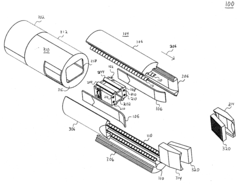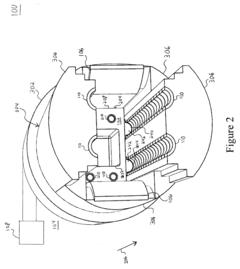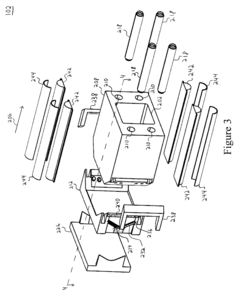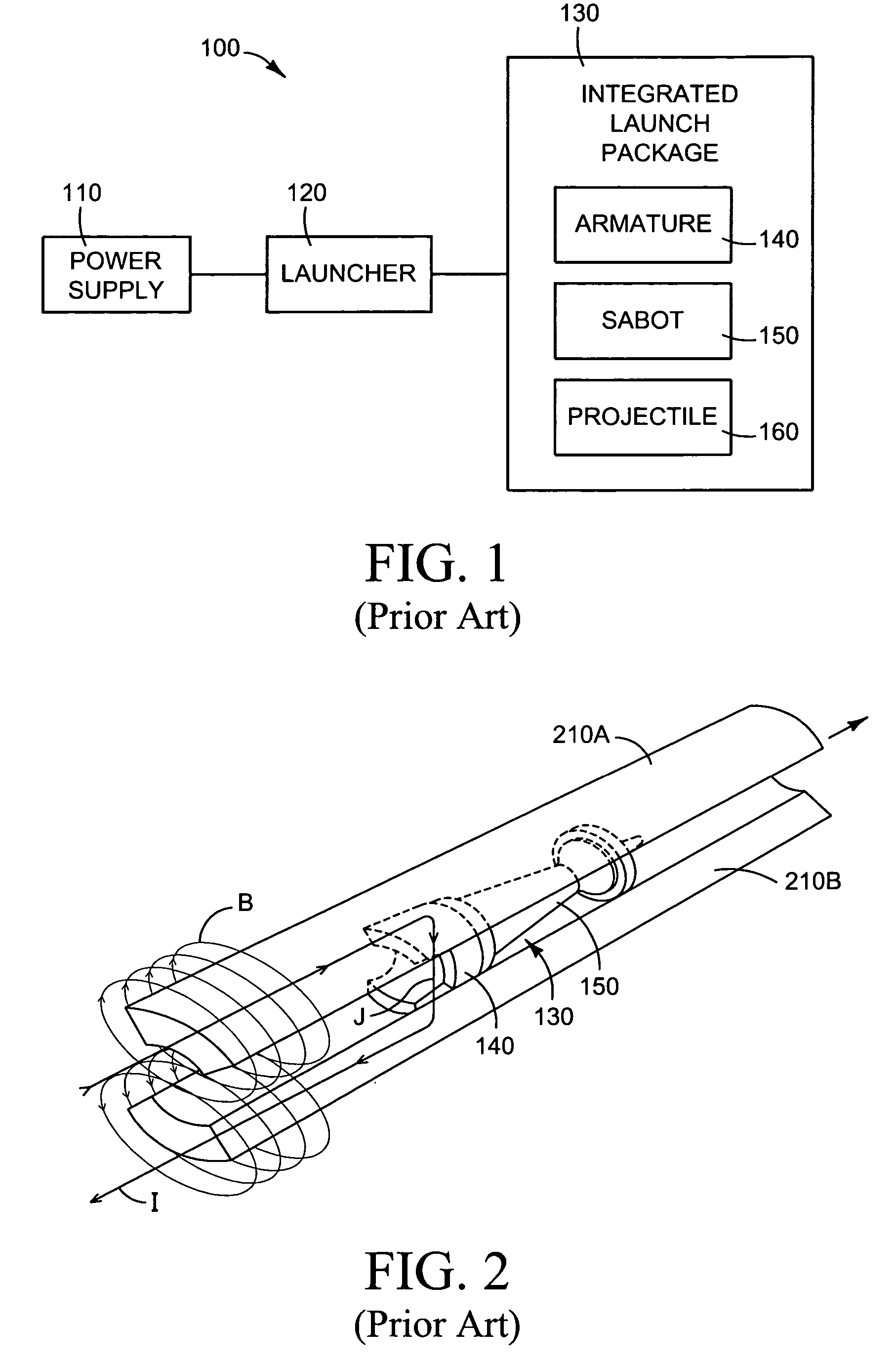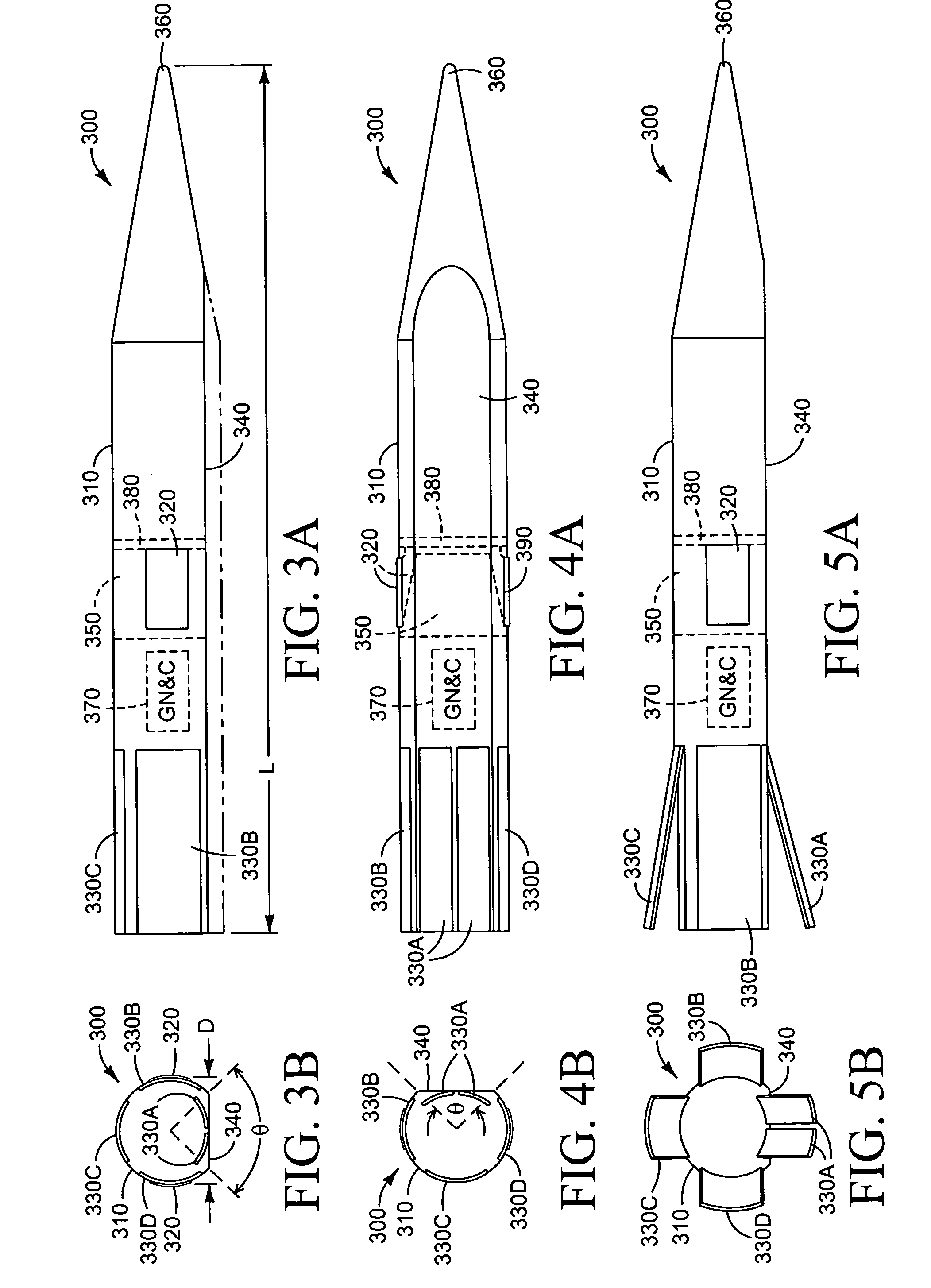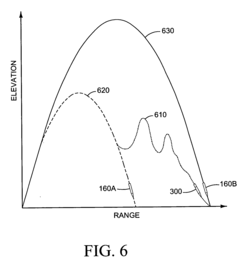Rail Gun Integration with Unmanned Combat Vehicles
AUG 6, 20259 MIN READ
Generate Your Research Report Instantly with AI Agent
Patsnap Eureka helps you evaluate technical feasibility & market potential.
Rail Gun Tech Evolution
The evolution of rail gun technology has been marked by significant advancements over the past century. Initially conceptualized in the early 1900s, rail guns remained largely theoretical until the late 20th century when practical demonstrations became feasible. The fundamental principle of electromagnetic propulsion has remained constant, but the implementation and efficiency have dramatically improved.
In the 1980s, research into rail guns gained momentum with increased funding from military organizations. This period saw the development of more powerful power supplies and improved materials for rails and projectiles. The 1990s brought about breakthroughs in capacitor technology, allowing for more compact and efficient energy storage systems, crucial for mobile rail gun applications.
The early 2000s marked a turning point with the first successful demonstrations of rail guns capable of launching projectiles at velocities exceeding Mach 7. This era also saw advancements in projectile design, focusing on aerodynamics and materials that could withstand the extreme forces involved in electromagnetic launch.
From 2010 onwards, the focus shifted towards miniaturization and integration with existing platforms. This phase has been critical for the potential integration of rail guns with unmanned combat vehicles. Researchers have been working on reducing the size and power requirements of rail gun systems while maintaining their performance characteristics.
Recent years have seen significant progress in thermal management and barrel longevity. The intense heat and wear generated during firing have been major obstacles, but new materials and cooling techniques have extended the operational life of rail gun components. Additionally, advancements in power electronics have led to more efficient and reliable firing systems.
The integration of rail guns with unmanned combat vehicles presents unique challenges and opportunities. Efforts are underway to develop compact power sources and energy storage systems that can meet the high power demands of rail guns while fitting within the constraints of unmanned platforms. This includes research into advanced battery technologies, supercapacitors, and even compact nuclear power sources.
Simultaneously, progress is being made in guidance systems and fire control for rail gun projectiles. The extreme velocities involved require sophisticated tracking and targeting systems, which are being adapted for use in unmanned vehicles. This includes the development of AI-driven targeting algorithms and advanced sensor integration.
Looking forward, the rail gun technology evolution is likely to focus on further miniaturization, increased fire rate, and improved accuracy at extended ranges. The integration with unmanned combat vehicles will drive innovations in autonomous operation, remote command and control, and real-time battlefield integration. As these technologies mature, we can expect to see rail guns transition from experimental systems to practical, deployable weapons on various unmanned platforms.
In the 1980s, research into rail guns gained momentum with increased funding from military organizations. This period saw the development of more powerful power supplies and improved materials for rails and projectiles. The 1990s brought about breakthroughs in capacitor technology, allowing for more compact and efficient energy storage systems, crucial for mobile rail gun applications.
The early 2000s marked a turning point with the first successful demonstrations of rail guns capable of launching projectiles at velocities exceeding Mach 7. This era also saw advancements in projectile design, focusing on aerodynamics and materials that could withstand the extreme forces involved in electromagnetic launch.
From 2010 onwards, the focus shifted towards miniaturization and integration with existing platforms. This phase has been critical for the potential integration of rail guns with unmanned combat vehicles. Researchers have been working on reducing the size and power requirements of rail gun systems while maintaining their performance characteristics.
Recent years have seen significant progress in thermal management and barrel longevity. The intense heat and wear generated during firing have been major obstacles, but new materials and cooling techniques have extended the operational life of rail gun components. Additionally, advancements in power electronics have led to more efficient and reliable firing systems.
The integration of rail guns with unmanned combat vehicles presents unique challenges and opportunities. Efforts are underway to develop compact power sources and energy storage systems that can meet the high power demands of rail guns while fitting within the constraints of unmanned platforms. This includes research into advanced battery technologies, supercapacitors, and even compact nuclear power sources.
Simultaneously, progress is being made in guidance systems and fire control for rail gun projectiles. The extreme velocities involved require sophisticated tracking and targeting systems, which are being adapted for use in unmanned vehicles. This includes the development of AI-driven targeting algorithms and advanced sensor integration.
Looking forward, the rail gun technology evolution is likely to focus on further miniaturization, increased fire rate, and improved accuracy at extended ranges. The integration with unmanned combat vehicles will drive innovations in autonomous operation, remote command and control, and real-time battlefield integration. As these technologies mature, we can expect to see rail guns transition from experimental systems to practical, deployable weapons on various unmanned platforms.
Military Demand Analysis
The integration of rail guns with unmanned combat vehicles represents a significant shift in military technology, driven by the evolving nature of modern warfare and the increasing demand for more efficient, powerful, and autonomous weapon systems. This combination addresses several key military needs and strategic objectives.
Firstly, there is a growing requirement for long-range precision strike capabilities in contemporary military operations. Rail guns offer the potential to deliver projectiles at hypersonic speeds over extended distances, far exceeding the range and accuracy of conventional artillery systems. When integrated with unmanned combat vehicles, this technology could provide military forces with a mobile, high-impact strike option that can be deployed rapidly and with minimal risk to personnel.
The demand for increased survivability and reduced human casualties in combat scenarios is another driving factor. Unmanned combat vehicles equipped with rail guns can be utilized in high-risk environments, minimizing the exposure of human operators to enemy fire. This aligns with the broader trend towards unmanned and autonomous systems in military applications, which aim to enhance operational capabilities while reducing the potential for human losses.
Furthermore, there is a persistent need for cost-effective solutions in military operations. While the initial development and integration costs may be substantial, rail gun technology offers the potential for significant long-term savings. The electromagnetic propulsion system eliminates the need for explosive propellants, reducing the logistical burden and associated costs of ammunition storage and transportation. When combined with the operational flexibility of unmanned vehicles, this could lead to more efficient and economical deployment of firepower.
The military also seeks to maintain technological superiority over potential adversaries. The development of rail gun-equipped unmanned combat vehicles demonstrates a commitment to cutting-edge technology and could serve as a powerful deterrent. This advanced weaponry may also provide tactical advantages in future conflicts, potentially shifting the balance of power in favor of the forces possessing such capabilities.
Additionally, there is an increasing emphasis on multi-domain operations in modern military strategy. Unmanned combat vehicles with rail guns could potentially operate across land, sea, and air domains, offering versatility and adaptability in various combat scenarios. This multi-domain capability aligns with the military's goal of achieving seamless integration and coordination across different operational environments.
Lastly, the demand for rapid response and precision engagement in urban warfare and counterinsurgency operations is driving the development of more sophisticated weapon systems. Rail gun-equipped unmanned vehicles could provide the necessary firepower and accuracy for such scenarios, while minimizing collateral damage through precise targeting and reduced reliance on explosive munitions.
Firstly, there is a growing requirement for long-range precision strike capabilities in contemporary military operations. Rail guns offer the potential to deliver projectiles at hypersonic speeds over extended distances, far exceeding the range and accuracy of conventional artillery systems. When integrated with unmanned combat vehicles, this technology could provide military forces with a mobile, high-impact strike option that can be deployed rapidly and with minimal risk to personnel.
The demand for increased survivability and reduced human casualties in combat scenarios is another driving factor. Unmanned combat vehicles equipped with rail guns can be utilized in high-risk environments, minimizing the exposure of human operators to enemy fire. This aligns with the broader trend towards unmanned and autonomous systems in military applications, which aim to enhance operational capabilities while reducing the potential for human losses.
Furthermore, there is a persistent need for cost-effective solutions in military operations. While the initial development and integration costs may be substantial, rail gun technology offers the potential for significant long-term savings. The electromagnetic propulsion system eliminates the need for explosive propellants, reducing the logistical burden and associated costs of ammunition storage and transportation. When combined with the operational flexibility of unmanned vehicles, this could lead to more efficient and economical deployment of firepower.
The military also seeks to maintain technological superiority over potential adversaries. The development of rail gun-equipped unmanned combat vehicles demonstrates a commitment to cutting-edge technology and could serve as a powerful deterrent. This advanced weaponry may also provide tactical advantages in future conflicts, potentially shifting the balance of power in favor of the forces possessing such capabilities.
Additionally, there is an increasing emphasis on multi-domain operations in modern military strategy. Unmanned combat vehicles with rail guns could potentially operate across land, sea, and air domains, offering versatility and adaptability in various combat scenarios. This multi-domain capability aligns with the military's goal of achieving seamless integration and coordination across different operational environments.
Lastly, the demand for rapid response and precision engagement in urban warfare and counterinsurgency operations is driving the development of more sophisticated weapon systems. Rail gun-equipped unmanned vehicles could provide the necessary firepower and accuracy for such scenarios, while minimizing collateral damage through precise targeting and reduced reliance on explosive munitions.
Current Challenges
The integration of rail guns with unmanned combat vehicles presents several significant challenges that need to be addressed for successful implementation. One of the primary obstacles is the enormous power requirements of rail guns. These electromagnetic weapons demand substantial electrical energy to accelerate projectiles to hypersonic speeds, which is particularly challenging for mobile platforms with limited onboard power generation capabilities.
Weight and size constraints pose another major hurdle. Rail guns are typically large and heavy systems, making their integration into unmanned vehicles, which often prioritize mobility and stealth, a complex engineering task. The need to balance the weapon's size and power with the vehicle's payload capacity and maneuverability is a critical design challenge.
Thermal management is a crucial concern in rail gun systems. The intense heat generated during firing can cause rapid wear of the rails and other components, potentially leading to reduced accuracy and shortened operational lifespan. Developing effective cooling systems that are compact enough to fit within the limited space of an unmanned vehicle is a significant technical challenge.
The durability and longevity of rail gun components under repeated high-stress firing conditions remain problematic. The extreme forces involved in launching projectiles at such high velocities can cause rapid degradation of the rail gun's barrel and other critical parts. Ensuring the reliability and maintainability of these systems in field conditions is essential for their practical deployment on unmanned platforms.
Precision and accuracy present another set of challenges. While rail guns offer the potential for extreme range and velocity, maintaining consistent accuracy over various distances and environmental conditions is complex. Factors such as the Earth's rotation (Coriolis effect) and atmospheric conditions become increasingly significant at the extended ranges these weapons can engage.
Integration of fire control systems and target acquisition capabilities with the unmanned vehicle's existing sensors and command systems is another area requiring significant development. Ensuring seamless communication and coordination between the weapon system and the vehicle's autonomous or remote control systems is crucial for effective operation.
Lastly, the logistical and operational challenges of deploying rail gun-equipped unmanned vehicles in combat scenarios need careful consideration. Issues such as ammunition supply, maintenance requirements, and the tactical employment of these advanced weapon systems in various combat environments must be thoroughly addressed to realize their full potential on the battlefield.
Weight and size constraints pose another major hurdle. Rail guns are typically large and heavy systems, making their integration into unmanned vehicles, which often prioritize mobility and stealth, a complex engineering task. The need to balance the weapon's size and power with the vehicle's payload capacity and maneuverability is a critical design challenge.
Thermal management is a crucial concern in rail gun systems. The intense heat generated during firing can cause rapid wear of the rails and other components, potentially leading to reduced accuracy and shortened operational lifespan. Developing effective cooling systems that are compact enough to fit within the limited space of an unmanned vehicle is a significant technical challenge.
The durability and longevity of rail gun components under repeated high-stress firing conditions remain problematic. The extreme forces involved in launching projectiles at such high velocities can cause rapid degradation of the rail gun's barrel and other critical parts. Ensuring the reliability and maintainability of these systems in field conditions is essential for their practical deployment on unmanned platforms.
Precision and accuracy present another set of challenges. While rail guns offer the potential for extreme range and velocity, maintaining consistent accuracy over various distances and environmental conditions is complex. Factors such as the Earth's rotation (Coriolis effect) and atmospheric conditions become increasingly significant at the extended ranges these weapons can engage.
Integration of fire control systems and target acquisition capabilities with the unmanned vehicle's existing sensors and command systems is another area requiring significant development. Ensuring seamless communication and coordination between the weapon system and the vehicle's autonomous or remote control systems is crucial for effective operation.
Lastly, the logistical and operational challenges of deploying rail gun-equipped unmanned vehicles in combat scenarios need careful consideration. Issues such as ammunition supply, maintenance requirements, and the tactical employment of these advanced weapon systems in various combat environments must be thoroughly addressed to realize their full potential on the battlefield.
Integration Solutions
01 Electromagnetic rail gun design
Rail guns use electromagnetic forces to accelerate projectiles to high velocities. The design typically involves parallel conducting rails and a sliding armature. When current flows through the system, it creates a powerful magnetic field that propels the projectile forward at extremely high speeds.- Electromagnetic rail gun design: Rail guns use electromagnetic forces to accelerate projectiles to high velocities. The design typically includes parallel conducting rails, a power source, and a projectile. When current flows through the rails and projectile, it creates a magnetic field that propels the projectile forward at extremely high speeds.
- Power supply and energy storage systems: Efficient power supply and energy storage are crucial for rail gun operation. This includes high-capacity capacitors, pulse-forming networks, and advanced battery technologies to provide the intense bursts of electrical energy required to launch projectiles at hypersonic speeds.
- Projectile design and materials: Specialized projectiles are developed to withstand the extreme forces and temperatures experienced during rail gun launch. These projectiles often incorporate advanced materials and aerodynamic designs to maintain stability and effectiveness at hypersonic velocities.
- Cooling and thermal management: Rail guns generate significant heat during operation, necessitating advanced cooling systems. This includes innovative heat dissipation methods, thermal-resistant materials, and active cooling technologies to maintain operational efficiency and extend the lifespan of rail gun components.
- Control systems and fire control: Sophisticated control systems are employed to manage rail gun operation, including precise timing of current flow, projectile loading, and targeting. Advanced fire control systems integrate sensors, computational models, and real-time adjustments to ensure accuracy and effectiveness in various operational scenarios.
02 Power supply and energy storage systems
Efficient power supply and energy storage are crucial for rail gun operation. This includes high-capacity capacitors, pulse-forming networks, and advanced power management systems to deliver the intense bursts of electrical energy required for projectile acceleration.Expand Specific Solutions03 Projectile design and materials
Specialized projectiles are developed for rail guns, considering factors such as conductivity, aerodynamics, and structural integrity under extreme acceleration. Materials research focuses on creating projectiles that can withstand the intense forces and temperatures involved in rail gun launches.Expand Specific Solutions04 Rail and armature materials
Advanced materials are used for rails and armatures to withstand the extreme conditions during firing. This includes research into high-conductivity alloys, composite materials, and surface treatments to reduce wear and extend the operational life of rail gun components.Expand Specific Solutions05 Control systems and fire control
Sophisticated control systems are employed for precise timing, aiming, and monitoring of rail gun operations. This includes advanced fire control computers, sensors for projectile tracking, and systems for managing the electromagnetic pulse generated during firing.Expand Specific Solutions
Key Industry Players
The research on rail gun integration with unmanned combat vehicles is in an early developmental stage, with a growing market potential as militaries seek advanced weaponry. The technology is still maturing, with key players like Rheinmetall Landsysteme, Boeing, and the US Army leading efforts. Universities such as Harbin Institute of Technology and Carnegie Mellon are contributing to foundational research. While not yet fully operational, the integration of rail guns with unmanned vehicles represents a significant advancement in military technology, attracting interest from defense contractors and research institutions worldwide. The market size is expected to expand as the technology progresses towards practical implementation and deployment.
Rheinmetall Landsysteme GmbH
Technical Solution: Rheinmetall Landsysteme GmbH has been actively researching the integration of railgun technology with unmanned combat vehicles, leveraging its expertise in land systems and advanced weaponry. Their approach focuses on developing modular railgun systems that can be easily integrated into various unmanned vehicle platforms[16]. Rheinmetall is working on compact, high-energy density power systems specifically designed to meet the demanding power requirements of railguns while fitting within the constraints of mobile platforms. They are also developing advanced materials and cooling systems to manage the extreme temperatures and wear associated with railgun operation[17]. The company's research includes the development of sophisticated fire control systems and targeting algorithms optimized for the unique ballistics of railgun projectiles, ensuring accuracy at extended ranges. Additionally, Rheinmetall is exploring the integration of railgun systems with their existing unmanned vehicle technologies, focusing on creating synergies between autonomous navigation, target acquisition, and weapon deployment[18].
Strengths: Extensive experience in land systems and weaponry, strong capabilities in vehicle integration, and expertise in European defense technologies. Weaknesses: Potential regulatory challenges in developing and deploying railgun technologies within the European Union.
The Boeing Co.
Technical Solution: Boeing has been actively researching the integration of railgun technology with unmanned combat vehicles, leveraging its expertise in both defense systems and autonomous platforms. Their approach focuses on developing scalable railgun systems that can be adapted to various vehicle sizes and power capabilities[13]. Boeing's research includes the design of lightweight, high-strength materials for railgun components to reduce overall system weight while maintaining performance. They are also working on advanced thermal management solutions to address the intense heat generated during railgun operation, which is crucial for sustained firing in mobile applications[14]. Boeing is developing integrated power and propulsion systems that can efficiently manage the high energy demands of railguns alongside vehicle mobility requirements. Additionally, the company is exploring the use of advanced sensors and AI-driven targeting systems to enhance the accuracy and effectiveness of railgun-equipped unmanned vehicles in dynamic battlefield environments[15].
Strengths: Extensive experience in defense and aerospace technologies, strong capabilities in systems integration, and expertise in unmanned vehicle development. Weaknesses: Potential challenges in adapting large-scale defense project management to more agile unmanned vehicle development cycles.
Core Rail Gun Patents
Railgun system
PatentInactiveUS20100194212A1
Innovation
- A railgun system that uses liquid metal, preferably aluminum or aluminum alloys, introduced into a gap between the armature and electrically conductive rails to reduce contact resistance and enhance acceleration, with features like a chamber for containing the liquid metal, a port for directing it into the gap, and a backing to conduct current and maintain the gap, optimizing the Lorentz force for speed.
Electromagnetic railgun projectile
PatentInactiveUS20070261543A1
Innovation
- The design includes an aeroshell with an integrated armature near the center-of-gravity and extendable flaps, allowing for increased lethality mass delivery and reduced armature transition by optimizing the aerodynamic lifting surface and flap control during flight.
Power Supply Innovations
Power supply innovations are crucial for the successful integration of rail guns with unmanned combat vehicles. The high energy requirements of rail guns pose significant challenges for traditional power systems, necessitating novel approaches to energy generation, storage, and distribution.
One of the most promising developments in this field is the advancement of high-density capacitor technology. These capacitors are capable of storing and releasing large amounts of energy rapidly, which is essential for powering rail guns. Recent breakthroughs in materials science have led to the development of ultra-capacitors with significantly higher energy densities than their predecessors. These innovations allow for more compact and efficient power storage solutions, making them ideal for integration into unmanned combat vehicles.
Another area of innovation is in the realm of pulsed power systems. These systems are designed to deliver extremely high power outputs in short bursts, which aligns perfectly with the operational requirements of rail guns. Recent advancements in solid-state switching technologies have greatly improved the efficiency and reliability of pulsed power systems, making them more suitable for mobile platforms like unmanned combat vehicles.
Hybrid power systems are also gaining traction in this field. By combining different power generation and storage technologies, these systems can provide the high power output required for rail gun operation while maintaining the energy efficiency necessary for extended vehicle operation. For example, a combination of advanced lithium-ion batteries, supercapacitors, and compact generators can offer a versatile and robust power solution.
Advancements in power management and distribution systems are equally important. Intelligent power management systems utilizing artificial intelligence and machine learning algorithms can optimize power allocation in real-time, ensuring that the rail gun receives the necessary energy while maintaining sufficient power for vehicle operations and other onboard systems.
Emerging technologies such as superconducting magnetic energy storage (SMES) systems are also being explored for their potential applications in rail gun power supply. These systems can store large amounts of energy with minimal losses and provide rapid discharge capabilities, making them well-suited for rail gun applications. However, challenges related to cryogenic cooling requirements need to be addressed for practical implementation in mobile platforms.
As research in this field progresses, we can expect to see further innovations in areas such as thermal management, energy harvesting technologies, and advanced power electronics. These developments will be crucial in overcoming the current limitations and enabling the widespread integration of rail guns with unmanned combat vehicles.
One of the most promising developments in this field is the advancement of high-density capacitor technology. These capacitors are capable of storing and releasing large amounts of energy rapidly, which is essential for powering rail guns. Recent breakthroughs in materials science have led to the development of ultra-capacitors with significantly higher energy densities than their predecessors. These innovations allow for more compact and efficient power storage solutions, making them ideal for integration into unmanned combat vehicles.
Another area of innovation is in the realm of pulsed power systems. These systems are designed to deliver extremely high power outputs in short bursts, which aligns perfectly with the operational requirements of rail guns. Recent advancements in solid-state switching technologies have greatly improved the efficiency and reliability of pulsed power systems, making them more suitable for mobile platforms like unmanned combat vehicles.
Hybrid power systems are also gaining traction in this field. By combining different power generation and storage technologies, these systems can provide the high power output required for rail gun operation while maintaining the energy efficiency necessary for extended vehicle operation. For example, a combination of advanced lithium-ion batteries, supercapacitors, and compact generators can offer a versatile and robust power solution.
Advancements in power management and distribution systems are equally important. Intelligent power management systems utilizing artificial intelligence and machine learning algorithms can optimize power allocation in real-time, ensuring that the rail gun receives the necessary energy while maintaining sufficient power for vehicle operations and other onboard systems.
Emerging technologies such as superconducting magnetic energy storage (SMES) systems are also being explored for their potential applications in rail gun power supply. These systems can store large amounts of energy with minimal losses and provide rapid discharge capabilities, making them well-suited for rail gun applications. However, challenges related to cryogenic cooling requirements need to be addressed for practical implementation in mobile platforms.
As research in this field progresses, we can expect to see further innovations in areas such as thermal management, energy harvesting technologies, and advanced power electronics. These developments will be crucial in overcoming the current limitations and enabling the widespread integration of rail guns with unmanned combat vehicles.
Ethical Considerations
The integration of rail guns with unmanned combat vehicles raises significant ethical considerations that must be carefully addressed. One primary concern is the potential for increased lethality and destruction, as rail guns can deliver projectiles at extremely high velocities over long distances. This capability could lead to unintended civilian casualties and disproportionate damage to infrastructure, challenging the principles of distinction and proportionality in armed conflict.
Furthermore, the automation of such powerful weapons systems on unmanned platforms introduces complex questions about human control and accountability. The decision-making process for target engagement becomes critical, as removing human operators from the immediate loop may increase the risk of errors or misjudgments. This raises concerns about compliance with international humanitarian law and the ethical implications of delegating lethal force decisions to autonomous systems.
The development and deployment of rail gun-equipped unmanned combat vehicles may also contribute to an arms race and escalate global tensions. As nations pursue increasingly advanced weaponry, there is a risk of destabilizing existing power balances and potentially lowering the threshold for armed conflict. This could undermine efforts towards international peace and security.
Additionally, the dual-use nature of rail gun technology presents ethical dilemmas. While it may have legitimate military applications, there is potential for misuse or proliferation to non-state actors, raising concerns about global security and the responsible development of advanced weapons systems.
Ethical considerations must also extend to the research and development phase. Scientists and engineers involved in such projects face moral questions about their role in creating weapons with significant destructive potential. This necessitates robust ethical frameworks and guidelines for those working in defense-related fields.
Lastly, the allocation of resources towards advanced military technology like rail gun-equipped unmanned vehicles raises questions about societal priorities. Ethical debates may arise regarding the balance between investment in defense capabilities and addressing other pressing global challenges, such as poverty, healthcare, and environmental protection.
Furthermore, the automation of such powerful weapons systems on unmanned platforms introduces complex questions about human control and accountability. The decision-making process for target engagement becomes critical, as removing human operators from the immediate loop may increase the risk of errors or misjudgments. This raises concerns about compliance with international humanitarian law and the ethical implications of delegating lethal force decisions to autonomous systems.
The development and deployment of rail gun-equipped unmanned combat vehicles may also contribute to an arms race and escalate global tensions. As nations pursue increasingly advanced weaponry, there is a risk of destabilizing existing power balances and potentially lowering the threshold for armed conflict. This could undermine efforts towards international peace and security.
Additionally, the dual-use nature of rail gun technology presents ethical dilemmas. While it may have legitimate military applications, there is potential for misuse or proliferation to non-state actors, raising concerns about global security and the responsible development of advanced weapons systems.
Ethical considerations must also extend to the research and development phase. Scientists and engineers involved in such projects face moral questions about their role in creating weapons with significant destructive potential. This necessitates robust ethical frameworks and guidelines for those working in defense-related fields.
Lastly, the allocation of resources towards advanced military technology like rail gun-equipped unmanned vehicles raises questions about societal priorities. Ethical debates may arise regarding the balance between investment in defense capabilities and addressing other pressing global challenges, such as poverty, healthcare, and environmental protection.
Unlock deeper insights with Patsnap Eureka Quick Research — get a full tech report to explore trends and direct your research. Try now!
Generate Your Research Report Instantly with AI Agent
Supercharge your innovation with Patsnap Eureka AI Agent Platform!
